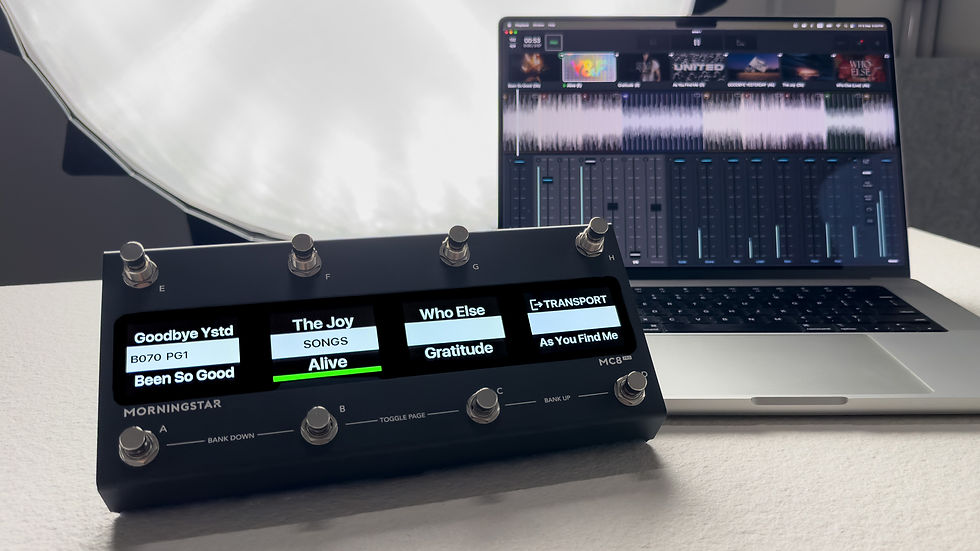The Power of MIDI for Guitarists
- Ben

- Jun 1, 2019
- 4 min read
Updated: Feb 16, 2021
Today we talk about how MIDI can benefit guitarists. Throughout your musical journey, you are bound to have come across MIDI. To many, it is the quintessential MIDI keyboard controller, and to others a vital component of their pedalboard. Undoubtedly MIDI has played a huge part in music making, and is here to stay. Some might ask, what exactly is MIDI? I for one was confused when I began, and can completely relate to those who may be unsure too. MIDI stands for Musical Instrument Digital Interface, and is a language by which different musical instruments and effects, including keyboards, pedals, amplifiers and even some guitars, communicate.
All devices regardless of brand or model, can communicate with each other as long as they are MIDI capable. It really is something marvellous to behold, something that changed the face of music forever. For that, we have the legendary Dave Smith to thank, the man who made this all possible back in 1983. He created this language and made it free for all to use, for the benefit of humankind, not pocketing a single cent from the creation of the MIDI standard. In the modern era of copyrights, patents and trademarks, Dave Smith is somewhat of a rarity, a modern altruistic pioneer if you will. It is safe to say that the history of music as we know it wouldn’t be the same without his contribution.

Meris Mercury 7 w/ ¼” MIDI jack vs Morningstar MC6 w/ DIN-5 MIDI jack
So how would you know if your pedal/device is MIDI capable? This biggest tell-tale sign would be the presence of a MIDI jack on the device (as shown above). The two most common types of MIDI connectors are the standard 5-pin DIN jacks and ¼” jacks. The basics of MIDI are pretty easy to pick up, but this article isn't about learning how to use MIDI, it is about how MIDI can benefit you and your music.
MIDI has stood the test of time, becoming increasingly relevant in the music scene of the 2010s and soon to be 2020s. While just about every keyboard and synth now has MIDI, the number of guitarists using MIDI is also growing fast! With the boom of pedalboards, from hand-carry metro-sized fly rigs to immense terra-sized, trolly-equipped spaceships, comes the increasing need for MIDI to be a part of the equation. No musician wants to tap dance on stage, turning on 2 different pedals, whilst turning another 2 off, only to do the reverse for the next chorus/verse. Neither does the next Steve Vai want to be individually switching off a Wah, turning on a boost and chorus while switching pickups, to enter into a blistering solo. MIDI negates the need for unnecessary athletics and time spent on switching effects. With the click of single a switch, multiple effects can be switched on and off.

A fully MIDI capable pedalboard
We've talked about turning on and off multiple effects with the click of a switch, but MIDI also enables users to adjust different effect parameters even without changing presets. Want to toggle between long trailing delays and short slap-back echoes? Shimmer reverb drenched in phaser tones or subtle chorus vibes? MIDI does all that instantaneously. Want to keep everything else the same but just turn up the regeneration on your favourite analog delay? Yep, MIDI does that too. There isn’t much that MIDI cannot do, it simply requires the appropriate messages to be sent. With that in place, it’s no wonder that many guitarists, synth players and even woodwind instrumentalists are beginning to incorporate MIDI into their rigs, both live and in the studio.
Take Red Hot Chili Peppers’ John Frusciante and Josh Klinghoffer who both have immense pedalboards for example. One can see the benefits of using MIDI in set-ups like theirs. With more than a dozen pedals in their signal chain, turning multiple pedals on and off for select parts of each song is simply impossible without a team of roadies to help. But that would be easily done with the click a switch on a MIDI controller.
Even smaller acoustic bar gig players benefit from incorporating MIDI controllers in their setup, removing the need to bend over from a high bar stool and adjust settings for different songs. What pedals would an acoustic guitarist use you might ask? Reverb and compressor for sure, with the occasional chorus and delay, all of which have several MIDI-capable offerings available. L.A. based Meris and Strymon immediately spring to mind, as does Chase Bliss Audio out of Minneapolis. There are countless other brands which have, or are beginning to, incorporate MIDI into their products, such as the Cooper FX Moment Machine, Dr Scientist Atmosphere and Free the Tone Flight Time, coupled with industry staples who have had MIDI for years, like the Electro-Harmonix POG.

Clockwise from top: Kemper Profiler, Fractal Audio Axe-Fx III, Free the Tone FT-1Y Flight Time, Meris Mercury 7, Red Panda Lab Tensor, Empress Echosystem, Morningstar MC6, Empress Reverb, Chase Bliss Audio Dark World, Strymon Timeline, GFI Specular Tempus
With more pedal makers offering MIDI-capable products from all over the globe, MIDI is undoubtedly here to stay. While the age of rock guitar might not presently be at its peak, the rise in popularity of Ambient, Shoegaze and more complex sound textures makes MIDI even more needful. MIDI might not be the solution to every problem faced by musicians, but it certainly solves a lot of them, and will continue to keep doing so.


